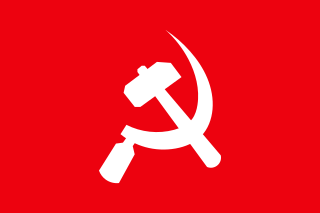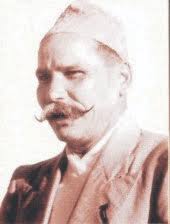
The Communist Party of Nepal, abbreviated CPN, was a communist party in Nepal from 1949 to 1962. It was founded on 15 September 1949 to struggle against the autocratic Rana regime, feudalism, and imperialism. The founding general secretary was Pushpa Lal Shrestha. The founding members of the Communist Party of Nepal were Moti Devi Shrestha, Niranjan Govinda Vaidya, Nar Bahadur Karmacharya and Narayan Bilas Joshi.
Nepal Rashtrabadi Gorkha Parishad, a pro-monarchy political party in Nepal. The party was founded in 1951 by members of the erstwhile Rana dynasty. The party was led by Bharat Shamsher JBR and MG Mrigendra Shamsher JBR.
Samyukta Prajatantra PartyNepal was a political party in Nepal. The party was led by Kunwar Inderjit Singh.
Rastriya Praja Party was a political party in Nepal, founded in 1952 when Matrika Prasad Koirala broke away from the Nepali Congress. As the leader of the party, M.P. Koirala was appointed prime minister by the King. The party did however, not develop any major support base of its own. A splinter group of the party did later join the Praja Parishad of Tanka Prasad Acharya.

Kunwar Indrajit Singh, popularly known as Dr. K.I. Singh or just K.I. Singh was a Nepali politician and revolutionary who served as the 20th Prime Minister of Nepal in 1957. He was key Nepali Congress in organizing the 1951 Nepali Revolution, and was a leader in its militant wing, the Muktisena, who later refused to recognize the Delhi Accord and was forced to flee the country following a revolt he took part in. In 1955 he returned and formed the United Democratic Party, and following the installation of the Panchayat system he agitated for its end, for which he was jailed. Following his release, he went into self-imposed exile, and much later returned to Nepal and was elected a member to the Rastriya Panchayat. He was known as the "Robin Hood of the Himalayas", and was very popular throughout the country.

Tanka Prasad Acharya was a Nepali politician who served as the 19th Prime Minister of Nepal from 1956 to 1957. He was one of the founders and the leader of the Nepal Praja Parishad, the first political party in Nepal with the goal of removing the Rana Dynasty's dictatorship.

The Nepal Praja Parishad was the first attempt to form an organization to lead the revolution against the Rana dynasty in Nepal. Led by Tanka Prasad Acharya, the group was founded in 1936, and is seen as the first political party in Nepal. The organisation collapsed after their plot to assassinate multiple members of the Rana regime was discovered, and some of its key members were executed.

Amik Sherchan is a Nepalese politician and current Governor of Lumbini Province of Nepal. He is former chairman of Janamorcha Nepal. He served as the Deputy Prime Minister & Health and Population Minister of Nepal in the interim government under Girija Prasad Koirala cabinet. He also served as the 2nd Governor of Gandaki Province of Nepal. He is active as a politician and prominent leader since 1967. He was elected as a member of the Pratinidhi Sabha and Member of 1st Constituent Assembly from Chitwan.

Mohan Shumsher Jang Bahadur Rana formed the first government of Nepal after the 1951 democracy movement. The government was formed by the proclamation of King Tribhuvan on 17 February 1951 and incorporated members of the Rana regime and the Nepali Congress. The king retained the right to dissolve the cabinet at any time and the cabinet would be responsible to him and the prime minister was to inform the king of all decisions.

Matrika Prasad Koirala formed the first government of Nepal by a commoner after he was appointed as the prime minister by King Tribhuvan. The government was formed after the previous government under Mohan SJB Rana fell after Nepali Congress ministers resigned. King Tribhuvan made a royal proclamation on 16 November 1951 and invited Matrika Prasad Koirala from the Nepali Congress to form the government.

Tanka Prasad Acharya formed a government on 27 January 1956 after being appointed as prime minister by King Mahendra. The cabinet was expanded in February 1957 to add more deputy ministers.

Kunwar Inderjit Singh formed a government on 26 July 1957 after being appointed by King Mahendra. He replaced Tanka Prasad Acharya who had resigned on the same day.

Bisheshwar Prasad Koirala formed the first elected government of Nepal on 27 May 1959. After the 1951 democratic movement, several transitional governments failed to hold the first general elections in the country until an interim government under Subarna SJB Rana held the 1959 general elections in two phases on 18 February and 3 April 1959. Nepali Congress gained a majority in the 1st House of Representatives of Nepal and Bishweshwar Prasad Koirala was elected as the parliamentary party leader of the Nepali Congress on 4 May 1959. On 16 May 1959, Koirala was invited by King Mahendra to form a government and the cabinet was formed on 27 May 1959 The cabinet was reshuffled just over a month later on 30 June 1959.
Krishna Prasad Sitaula is a Nepali politician, belonging to the Nepali Congress. Krishna Sitaula is known for playing an important role during the comprehensive peace accord.









